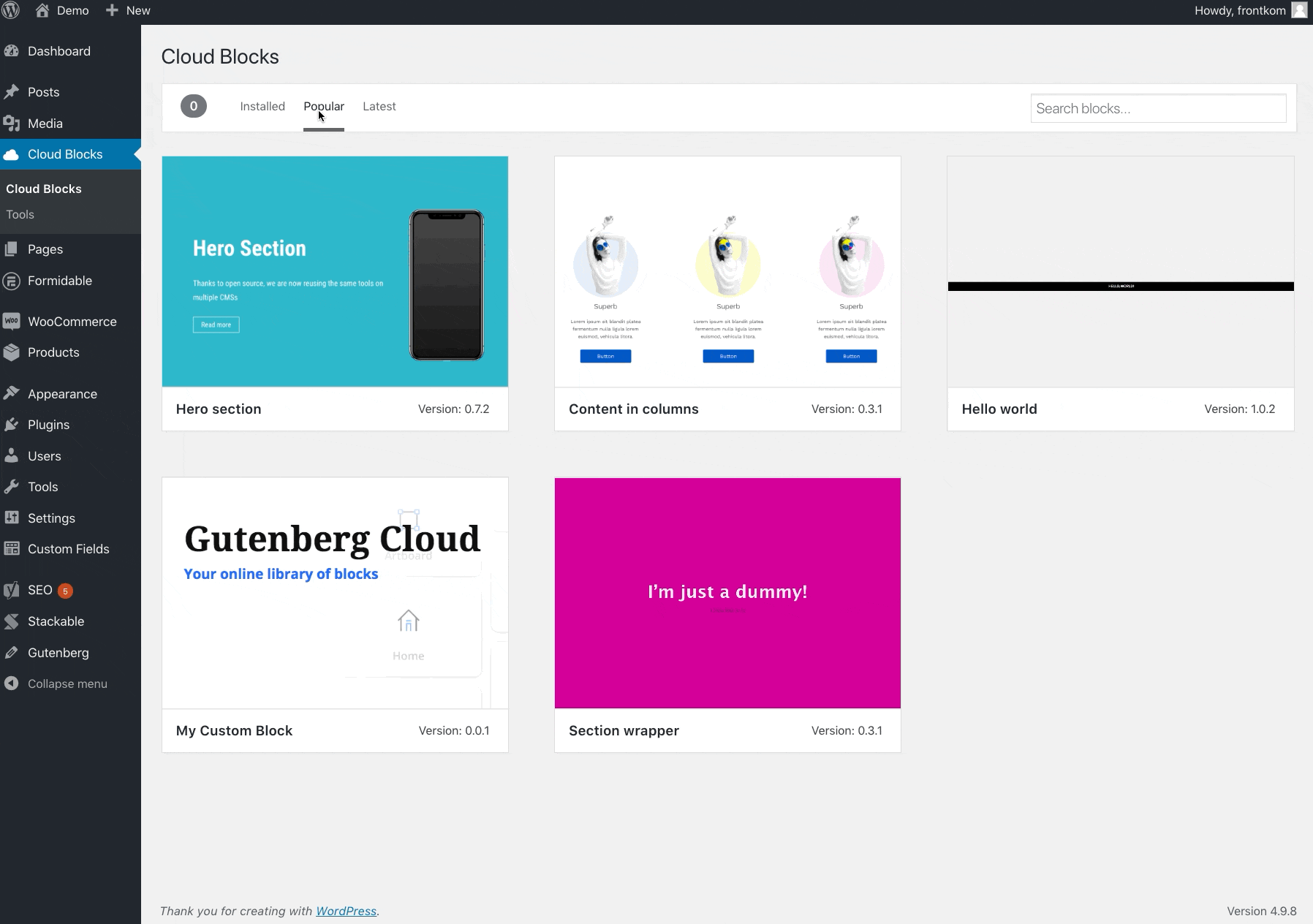Frontkom, the team behind the Gutenberg Cloud project, has published the beta version of its WordPress plugin to the official repository. Cloud Blocks serves as a connector, allowing WordPress users to browse and install open source blocks from Gutenberg Cloud. The blocks are hosted on NPM and their assets are served from CloudFlare using unpkg.com.
Gutenberg Cloud’s online library of blocks is CMS agnostic, offering blocks for both Drupal and WordPress sites, and more CMSs in the future. The service advertises three key benefits for developers who host blocks on Gutenberg Cloud:
- Wider adoption: Your blocks can be used outside of WP
- Discoverability: Your blocks will pop up in the Cloud Blocks UI
- Faster development: No plugin/SVN needed, just publish to NPM
Frontkom is actively recruiting WordPress developers to add blocks to the cloud to test the process. Documentation for migrating blocks from a plugin is available on GitHub. Frontkom has also produced a new boilerplate generator for building Gutenberg Cloud blocks.
Users should note that the team is still ironing out the experience for developers adding blocks to the cloud, so the plugin isn’t yet ready for general use. It’s currently under active development.
WordPress Developers Say Gutenberg Cloud May Not be the Best Way to Release Blocks but Platform has Potential
I contacted some WordPress developers who have tested sending their blocks to Gutenberg Cloud to get their initial reactions to the platform.
“The idea that folks will be able to install blocks a la carte is interesting,” CoBlocks author and ThemeBeans founder Rich Tabor said. “It’s pretty much as easy as installing plugins.”
Tabor experimented with migrating his Block Gallery blocks and said the process was not difficult but he foresees difficulties in maintaining blocks across parent plugins and Gutenberg Cloud.
“As a developer, I’m still not entirely convinced Gutenberg Cloud is the best way to release blocks, aside from relatively simple blocks,” Tabor said. “I personally lean towards building suites of blocks that share a relative purpose, instead of one plugin (or one Cloud Block instance) per block. For one, it cuts down on maintenance quite a bit, as custom components can be shared between blocks. And there’s much better discoverability on getting relative blocks in the hands of users — if they’re grouped together.”
Block collections have been criticized for making it difficult to search for and discover individual blocks, but Tabor makes some good arguments for improving block discoverability by grouping together features users often need. That is the whole point of successful plugins like Jetpack, but this type of packaging also lends itself to criticism about bloat.
“It’s a similar conundrum when we look at grouped/not grouped shortcode plugins,” Tabor said. “I suppose the main difference is that the nature of blocks is much more complicated than that of shortcodes. History seems to repeat itself.”
Tabor said he is considering distributing a few of his free blocks through Gutenberg Cloud but he hasn’t fully decided yet.
WordPress core contributor, Josh Pollock, who has worked extensively with React and Gutenberg, also tested the Gutenberg Cloud platform. He said he thinks it has a lot of potential for developers who write blocks that are mainly JavaScript already.
“I could see how an agency that builds WordPress sites could save a lot of time and hassle building out a block library,” Pollock said. “As a plugin developer with a lot of little ideas, the pain and time of setting up a block and block environment, which no one has gotten right yet, makes me very excited about this.”
Pollock also reported a positive experience with the create-cloud-block generator.
“The code that create-cloud-block generates is well-written, but not too opinionated,” Pollock said. “The developer experience is both really cool — you preview your block in a functional Gutenberg-powered editor with no WordPress site attached — and a little frustrating as there is no live reload yet. I know they are just getting started and the tool doesn’t lock you into any structure, which is great. I’ll be keeping my eye on this project.”
Frontkom CTO Per André Rønsen said his team will continue testing the cloud internally until they get more developer feedback on the corresponding WordPress plugin. For Drupal users, Gutenberg Cloud will be shipped as a submodule of Gutenberg, which means all sites that install Gutenberg will also get the Cloud module. It can, however, be disabled. Rønsen said his team plans to showcase Gutenberg Cloud for D8 at DrupalCamp Oslo in November.

It’s awesome to see cross-platform adoption of Gutenberg — we’re helping create the future of the web not just of WordPress.